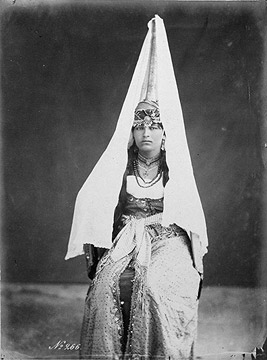Image Resource Bank
Image Gallery |  12 of 15
12 of 15 
Druze Woman from the Chouf Region of Modern-Day Lebanon Wearing a Tantur
The Druze (Arabic: Durzi‚) were an offshoot of an Ismaili sect that settled, following persecution, in the Chouf mountains in Lebanon. Today they are distributed across the borders of Lebanon, Syria, Israel, and Jordan, and a large Diaspora. They are Arabic speakers and have often identified with pan-Arabism in Lebanon and Syria, in particular during the period of French colonial domination. They are, though, set apart by their sectarian identity, which has allowed for a strong sense of identification with the Israeli state. Many Druze have served in the Israeli Defense Forces, for instance. This picture of a Druze woman is from ca 1870, by the French photographer Felix Bonfils, whose studio (a family business for a couple of generations) specialized in pictures of views and exotica for a burgeoning Western tourist trade in the eastern Mediterranean. The colonial gaze, one might say, has exacerbated Druze senses of difference.
From Wikipedia: “A retouched picture (by French photographer Bonfils showing a typical but formally dressed Druze woman from the shouf region of the shouf mountains, now part of Lebanon (c. 1870). Her unique head gear is called a tartur, popular with Druze women at the time.”
![]() Kurdish Squatter-Town (gecekondu) Dwellings in Istanbul, 1996.
Kurdish Squatter-Town (gecekondu) Dwellings in Istanbul, 1996.
Name: Druze Woman from Chouf Region of Modern Day Lebanon Wearing a Tantur
Material: Unknown
Size: 396 x 534 pixels (66 KB)
Date: ca. 1870s
Place of Origin: Chouf, modern Lebanon
Location: Wikimedia Commons
Source and Registration#: Wikimedia Commons. Link to resource![]() (accessed May 7, 2010).
(accessed May 7, 2010).

 Martin Stokes
Martin Stokes
Fellow of St. John’s College, Oxford University




